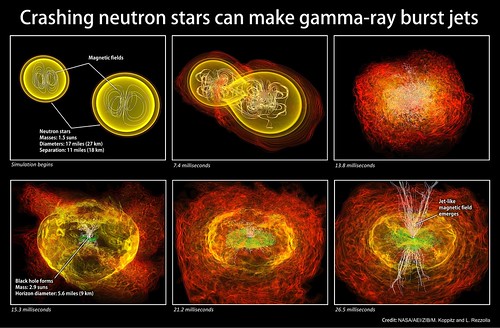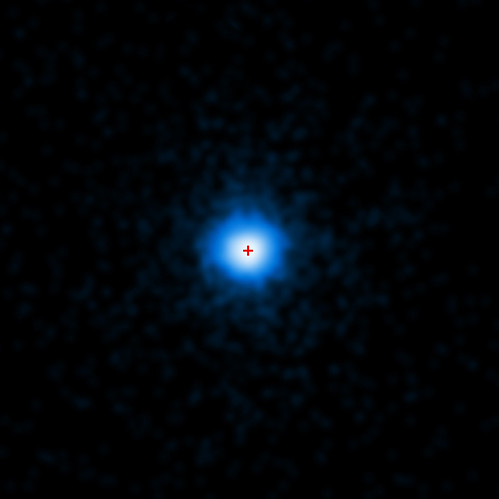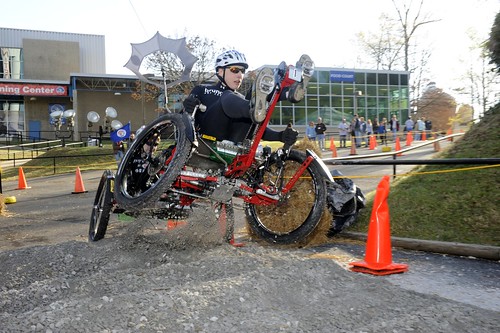Awesomeness Round-up – 4/11/11
- By Maggie Masetti
- April 11, 2011
- Comments Off on Awesomeness Round-up – 4/11/11
Sorry we were slow with posts last week – we were swamped with preparations for the government shut-down that (thankfully) never happened. We’ve got a bunch of things in the works, but we’ll start with a link round-up.
Gamma-ray Bursts (GRBs) are huge explosions in space, and scientists think they happen either when a very massive star explodes or when two very dense neutron stars collide. Either way, it’s thought that a GRB signals the birth of a black hole. Very short duration GRBs are less common than another kind of burst that lasts longer, more than two seconds. Also, their shorter duration makes them harder to study. This new supercomputer simulation of short GRBs has shown that merging neutron stars could indeed power short GRBs. You can read all the details in this web feature.
Below are images from this simulation.

Credit: NASA/AEI/ZIB/M. Koppitz and L. Rezzolla
Stunning video footage from the Solar Dynamics Observatory (SDO). Cascades of spiraling magnetic loops observed in extreme ultraviolet light dance and twist above an active region on the Sun (Apr. 3-5, 2011). These loops are charged particles spinning along the magnetic field lines, and thus visually revealing them. The bright active region was fairly strong and the activity persistent, though not explosive. At one point darker plasma can be seen being pulled back and forth across the region’s center.
Credit: NASA/GSFC/SDO
NASA’s 18th annual Great Moonbuggy Race was run at the U.S. Space and Rocket Center in Huntsville, Ala., on April 1-2, 2011. In this photo, the moonbuggy team from the International Space Education Institute, Leipzig, Germany, kicks up a spray of gravel and then literally flies over an obstacle on the moonbuggy course – all while executing a controlled, safe landing on the other side. You can get all the details on the 2011 Great Moonbuggy Race in the press release. There are also a ton of photos over on NASA Marshall’s Flickr photostream.
Three of NASA satellites (Swift, Hubble, and Chandra) teamed up to study a puzzling cosmic blast. It was different than a normal gamma-ray burst, which tends to flare and then fade. This particular blast continued to brighten and fade for more than a week, and astronomers say they’ve never seen anything this bright, long-lasting, and variable before. Research is ongoing, but astronomers think the blast was the result of a star wandering too close to its galaxy’s central supermassive black hole. Intense tidal forces tore the star apart, and the infalling gas continued to stream toward the hole over an extended period of time. The black hole might have formed a jet, which happened to point in our direction, giving us a view of the powerful blast of X-rays and gamma-rays.
Here are three images, one from each satellite of this same event, called GRB 110328A.
Below is a combined view from Swift’s Ultraviolet/Optical (white, purple) and X-ray telescopes (yellow and red) were combined in this view of GRB 110328A. The blast was detected only in X-rays, which were collected over a 3.4-hour period on March 28.

Credit: NASA/Swift/Stefan Immler
This is a visible-light image of GRB 110328A’s host galaxy (arrow) taken on April 4 by the Hubble Space Telescope’s Wide Field Camera 3.

Credit: NASA/ESA/A. Fruchter (STScI)
NASA’s Chandra X-ray Observatory completed this four-hour exposure of GRB 110328A on April 4. The center of the X-ray source corresponds to the very center of the host galaxy imaged by Hubble (red cross).

Credit: NASA/CXC/ Warwick/A. Levan
SOFIA took its first flight, and the results look very good! More info on the SOFIA NASA.gov mission page and image gallery.
We’ve got a mutual admiration society going with Astronomy magazine’s columnist Bill Andrews. We were excited he included us on his “Cosmic Grid”, and he was excited that we blogged about it, and then we were excited that he blogged about us blogging about it. I have a feeling there are more recursive pictures in our future!




